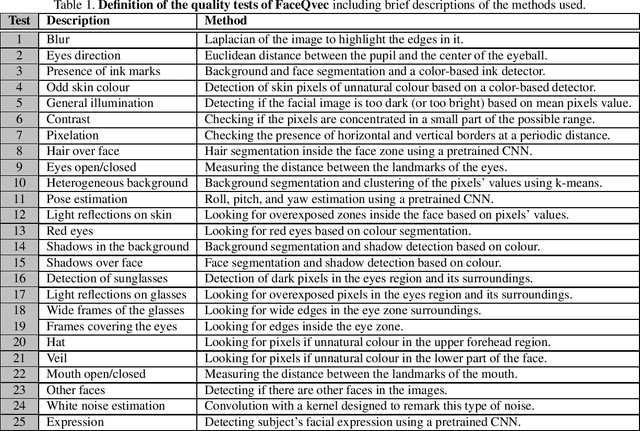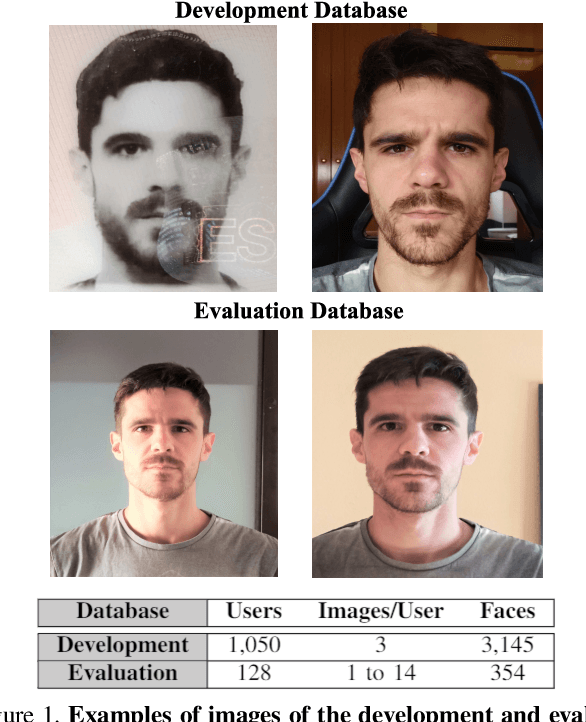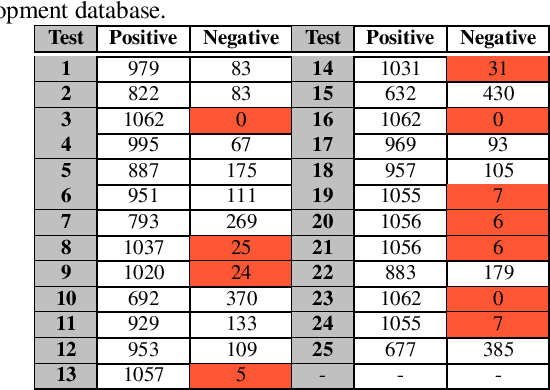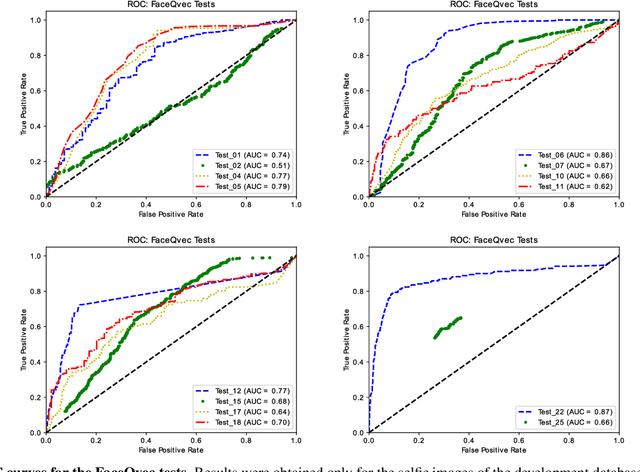Francisco Zamora-Martinez
Comprehensive Equity Index (CEI): Definition and Application to Bias Evaluation in Biometrics
Sep 03, 2024Abstract:We present a novel metric designed, among other applications, to quantify biased behaviors of machine learning models. As its core, the metric consists of a new similarity metric between score distributions that balances both their general shapes and tails' probabilities. In that sense, our proposed metric may be useful in many application areas. Here we focus on and apply it to the operational evaluation of face recognition systems, with special attention to quantifying demographic biases; an application where our metric is especially useful. The topic of demographic bias and fairness in biometric recognition systems has gained major attention in recent years. The usage of these systems has spread in society, raising concerns about the extent to which these systems treat different population groups. A relevant step to prevent and mitigate demographic biases is first to detect and quantify them. Traditionally, two approaches have been studied to quantify differences between population groups in machine learning literature: 1) measuring differences in error rates, and 2) measuring differences in recognition score distributions. Our proposed Comprehensive Equity Index (CEI) trade-offs both approaches combining both errors from distribution tails and general distribution shapes. This new metric is well suited to real-world scenarios, as measured on NIST FRVT evaluations, involving high-performance systems and realistic face databases including a wide range of covariates and demographic groups. We first show the limitations of existing metrics to correctly assess the presence of biases in realistic setups and then propose our new metric to tackle these limitations. We tested the proposed metric with two state-of-the-art models and four widely used databases, showing its capacity to overcome the main flaws of previous bias metrics.
PAD-Phys: Exploiting Physiology for Presentation Attack Detection in Face Biometrics
Oct 03, 2023Abstract:Presentation Attack Detection (PAD) is a crucial stage in facial recognition systems to avoid leakage of personal information or spoofing of identity to entities. Recently, pulse detection based on remote photoplethysmography (rPPG) has been shown to be effective in face presentation attack detection. This work presents three different approaches to the presentation attack detection based on rPPG: (i) The physiological domain, a domain using rPPG-based models, (ii) the Deepfakes domain, a domain where models were retrained from the physiological domain to specific Deepfakes detection tasks; and (iii) a new Presentation Attack domain was trained by applying transfer learning from the two previous domains to improve the capability to differentiate between bona-fides and attacks. The results show the efficiency of the rPPG-based models for presentation attack detection, evidencing a 21.70% decrease in average classification error rate (ACER) (from 41.03% to 19.32%) when the presentation attack domain is compared to the physiological and Deepfakes domains. Our experiments highlight the efficiency of transfer learning in rPPG-based models and perform well in presentation attack detection in instruments that do not allow copying of this physiological feature.
FaceQvec: Vector Quality Assessment for Face Biometrics based on ISO Compliance
Nov 03, 2021



Abstract:In this paper we develop FaceQvec, a software component for estimating the conformity of facial images with each of the points contemplated in the ISO/IEC 19794-5, a quality standard that defines general quality guidelines for face images that would make them acceptable or unacceptable for use in official documents such as passports or ID cards. This type of tool for quality assessment can help to improve the accuracy of face recognition, as well as to identify which factors are affecting the quality of a given face image and to take actions to eliminate or reduce those factors, e.g., with postprocessing techniques or re-acquisition of the image. FaceQvec consists of the automation of 25 individual tests related to different points contemplated in the aforementioned standard, as well as other characteristics of the images that have been considered to be related to facial quality. We first include the results of the quality tests evaluated on a development dataset captured under realistic conditions. We used those results to adjust the decision threshold of each test. Then we checked again their accuracy on a evaluation database that contains new face images not seen during development. The evaluation results demonstrate the accuracy of the individual tests for checking compliance with ISO/IEC 19794-5. FaceQvec is available online (https://github.com/uam-biometrics/FaceQvec).
Online Learning Algorithm for Time Series Forecasting Suitable for Low Cost Wireless Sensor Networks Nodes
Apr 21, 2015



Abstract:Time series forecasting is an important predictive methodology which can be applied to a wide range of problems. Particularly, forecasting the indoor temperature permits an improved utilization of the HVAC (Heating, Ventilating and Air Conditioning) systems in a home and thus a better energy efficiency. With such purpose the paper describes how to implement an Artificial Neural Network (ANN) algorithm in a low cost system-on-chip to develop an autonomous intelligent wireless sensor network. The present paper uses a Wireless Sensor Networks (WSN) to monitor and forecast the indoor temperature in a smart home, based on low resources and cost microcontroller technology as the 8051MCU. An on-line learning approach, based on Back-Propagation (BP) algorithm for ANNs, has been developed for real-time time series learning. It performs the model training with every new data that arrive to the system, without saving enormous quantities of data to create a historical database as usual, i.e., without previous knowledge. Consequently to validate the approach a simulation study through a Bayesian baseline model have been tested in order to compare with a database of a real application aiming to see the performance and accuracy. The core of the paper is a new algorithm, based on the BP one, which has been described in detail, and the challenge was how to implement a computational demanding algorithm in a simple architecture with very few hardware resources.
* 28 pages, Published 21 April 2015 at MDPI's journal "Sensors"
 Add to Chrome
Add to Chrome Add to Firefox
Add to Firefox Add to Edge
Add to Edge